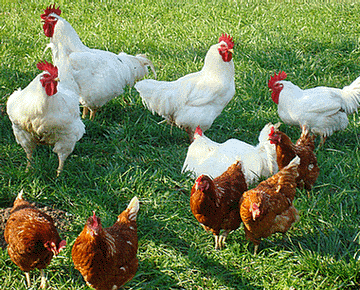By Brandon Moseley
Alabama Political Reporter
The Alabama Department of Agriculture and Industries released the 53rd edition of Alabama Agricultural Statistics in conjunction with the United States Department of Agriculture’s Alabama office of the National Agricultural Statistics Service. Alabama Commissioner of Agriculture and Industries John McMillan said that 2011 budget cuts to his department almost prevented this year’s report from being published.
However, farms groups including the Alabama Poultry and Egg Association, the Alabama Cattlemen’s Association, the Alabama Farmer’s Federation, and the Alabama Agribusiness Council pledged funds to allow the report to be finished.
Alabama farmers raised 1,033,400,000 chickens for America’s dinner tables in 2010 generating $2.79 billion in farm income. Alabama’s broiler production was up 3 percent from 2009 and receipts were up 11 percent. The top county for broiler chicken production was Cullman County with 120 million birds followed by DeKalb, Marshall, and Coffee counties. Alabama is the number three state in the nation in broilers raised, trailing only Georgia and Arkansas. Alabama’s commercial broiler hatcheries hatched 1.29 billion chicks, 224 million of which were raised in Georgia and Mississippi. Alabama had an inventory of 9,459,000 hens for laying eggs in 2010.
Alabama farms raised 2.18 billion eggs including 376 million eggs for direct human consumption. Cash receipts from eggs were $291.3 million. That is up 2 percent from 2009. Poultry and eggs sales generated 60.7 percent of Alabama’s total agricultural income.
At the beginning of 2011, Alabama had 1,230,000 cows and calves. The total sales of cattle in 2010 generated $395.8 million for Alabama’s farm economy. Alabama’s beef cow herd was 659,000 which was down slightly. Alabama has 11,000 milk cows. Alabama dairies raised 159 million pounds of milk which generated $30.8 million. Milk production was down 3 percent but the value of the milk produced was up 21 percent. The average Alabama milk cow produced 14,455 pounds of milk in 2010. The top counties for cows were Cullman, DeKalb, Montgomery, and Marshall.
Alabama’s herd of breeding hogs remained at 16,000. Some 251,000 pigs were born on Alabama’s farms in 2010. The total sales of hogs and pigs generated $42.35 million. The average number of pigs per litter was 8.10 which is down significantly from 8.47 in 2009.
Alabama’s catfish farms had $107.5 million in sales in 2010. This is up 19 percent from 2009 although total acreage of ponds has dropped to just 19,200 acres of water.
Alabama has 56,500 meat type goats and 4,000 dairy goats. Total goat numbers are down 8.6 percent from 2009.
Alabama’s beekeepers had 9000 bee colonies that produced 456,000 pounds of honey generating $1,079,000 in 2009.
Alabama’s top four commodity crops are corn, cotton, peanuts, and soybeans.
Alabama farmers planted 20,000 more acres in crops than they did in 2009.
The report showed 270,000 acres were planted in corn. Of those, 250,000 acres were harvested and the total crop produced was $139.2 million, up over $34 million from 2009. The average yield per acre was 116 bushels of corn up from 108 bushels per acre in 2009. Alabama farmers harvested 29 million bushels of corn in 2010.
Alabama farmers planted 340,000 acres of cotton in 2010 which brought a harvest of 480,000 bales of cotton. The total harvest was worth $199.1 million.
The report showed 190,000 acres of peanuts. The average acre yielded 2,600 pounds of peanuts which were down from 3,300 pounds per acre in 2009. The total yield in 2010 was 481 million pounds generating $89.9 million.
Acres planted in soybeans decreased by 20 percent from 2009 to just 350,000 acres. The average yield was just 26 bushels per acre for a total harvest of 8.9 million bushels producing $100.5 million down $71.5 million from 2009.
Alabama farmers planted 32 percent less wheat than they did in 2009 and 115,000 harvested acres yielded an average of 55 bushels per acre. Total production was 6.3 million bushels of wheat valued at $31.6 million.
Some 1.87 million tons of hay was harvested from 780,000 acres of grassland. The total hay produced in 2010 was estimated to be worth $168.5 million.
Other farmers planted 3,300 acres in sweet potatoes yielding 480,000 pounds up 89,000 pounds from 2009 but generating just $4.8 million because of the lowest price in the last ten years ($6.56 per 100 pounds).
Alabama’s greenhouse, sod farms, and plant nurseries generated another $289.9 million to total agricultural income.
The number of Alabama farms peaked in 1930 with 260,000 farming 23 million acres. Today Alabama has 48,500 farms with 9 million acres. The value of an acre of farm real estate in Alabama has dropped to $2,050 an acre in 2011. Cropland averaged $2,350 while pastureland averaged $1,600 per acre.
The values have dropped since the 2008 highs.
To see the report go to: http://www.nass.usda.gov/Statistics_by_State/Alabama/Publications/Annual_Statistical_Bulletin/2011/2011AlabamaAgricultureStatistics.pdf



















































